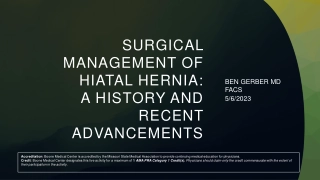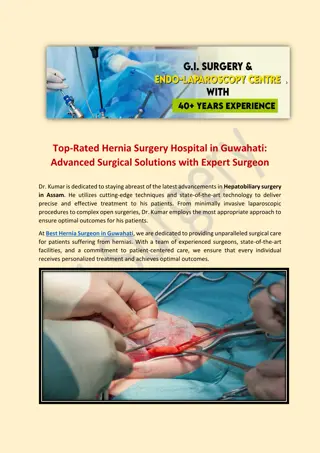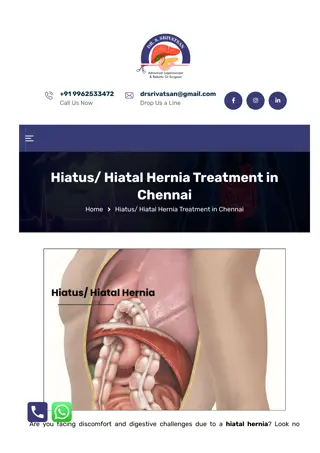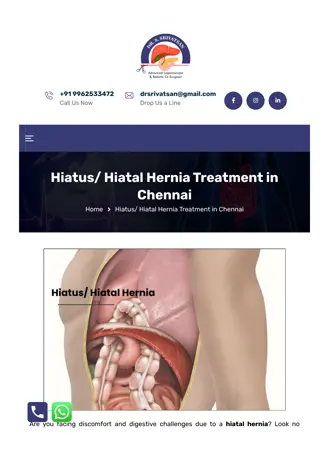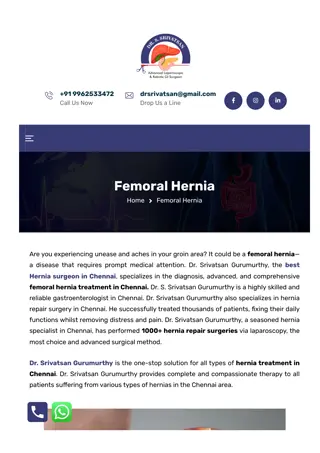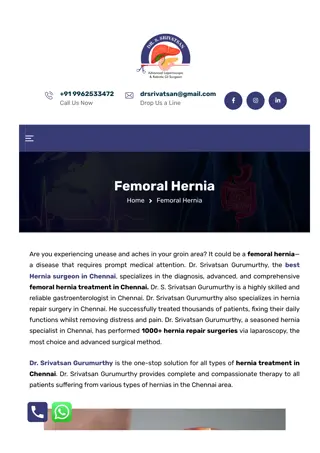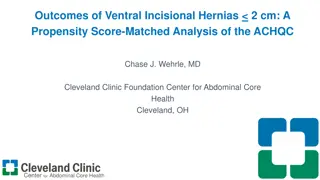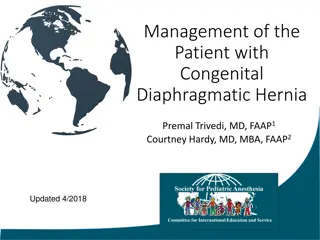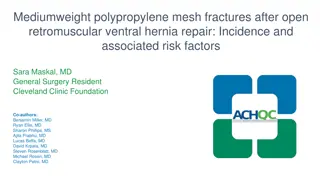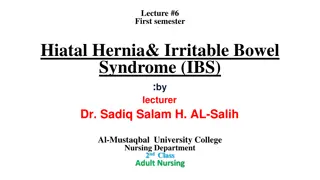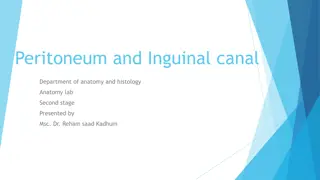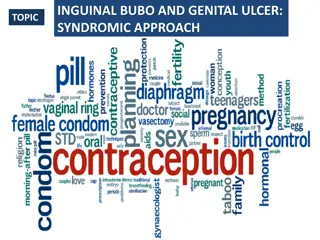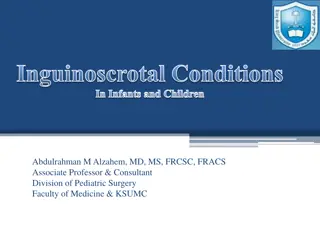Comprehensive Overview of Inguinal Hernia: Anatomy, Presentation, and Treatment
Inguinal hernia is characterized by an abnormal protrusion of viscus or a part of it through a weak point in the abdominal wall. It involves the anatomy of the inguinal region, including the superficial and deep inguinal rings, inguinal canal boundaries, and defense mechanisms. The anatomical classification distinguishes between indirect and direct hernias, with indirect hernias being more common, especially in younger individuals. The herniation of abdominal contents through the deep ring into the inguinal canal can lead to complications if left untreated.
Download Presentation

Please find below an Image/Link to download the presentation.
The content on the website is provided AS IS for your information and personal use only. It may not be sold, licensed, or shared on other websites without obtaining consent from the author.If you encounter any issues during the download, it is possible that the publisher has removed the file from their server.
You are allowed to download the files provided on this website for personal or commercial use, subject to the condition that they are used lawfully. All files are the property of their respective owners.
The content on the website is provided AS IS for your information and personal use only. It may not be sold, licensed, or shared on other websites without obtaining consent from the author.
E N D
Presentation Transcript
Hernia: Inguinal Surgical anatomy, presentation, treatment, complications Dr Amit Gupta Associate Professor Dept Of Surgery
Introduction Abnormal protrusion of viscus or a part of it through a weak point in the abdominal wall
Anatomy of inguinal region Superficial inguinal ring- triangular aperture in the aponeurosis of the ext oblique muscle . Lies 1.25 cm above the pubic tubercle . Normally it doesn t admit the tip of the little finger. Deep inguinal ring U shaped condensation of the fascia trasversalis Lies 1.25cm above the mid inguinal point.
Inguinal canal Oblique passage in the lower part of the anterior abdominal wall. Extends from deep inguinal ring to superficial inguinal ring. Directed downwards forwards and medially About 4cm long
Boundaries Anterior Ext. oblique aponeurosis & conjoined muscle laterally. Posterior Fascia transversalis & the conjoined tendon. Superiorly conjoined muscle. Inferiorly inguinal ligament.
Contents Spermatic cord Ilioinguinal nerve Genital branch of genitofemoral nerve Females Round ligament is present instead of spermatic cord. Spermatic cord constitutes- vas deferens, testicular & cremastic arteries , pampiniform plexus of veins, lymphatics
Defence mechanism of inguinal canal Obliquity of the inguinal canal. Shutter mechanism-due to conjoined tendon contraction
Anatomical classification Indirect hernia more common about 2/3 of inguinal hernia . It is more common in young Direct hernia- more common in old
Indirect hernia the abdominal contents herniation occurs through the deep ring into the inguinal canal. Comes out through the superficial ring. It may extend into the scrotum. Depending upon extent it may be complete or incomplete.
Direct hernia contents herniate directly through the posterior wall of the inguinal canal through the Hesselbach s triangle It is a weakness in posterior wall of the inguinal canal It is bounded laterally -inferior epigastric artery, medially lateral border of rectus abdominus muscle inferiorly inguinal ligament
Female inguinal hernia Male inguinal hernia
Clinical types Reducible contents can be returned into the abdominal cavity. Irreducible contents cannot be returned into the abdominal cavity. Obstructed irreducibilty + intestinal obstruction, but the blood supply is not impaired. Strangulated- irreducibilty + intestinal obstruction+ arrest of the blood supply. Inflammed- rare condition. Occurs when contents eg. Appendix,meckel s diverticulum is inflamed
Epidemiology Approximately 7% of all surgical outpatient. Accounts for 96% groin hernias (other 4% are femoral) Bilateral in 20% of cases Lifetime risk of inguinal hernia: 10% M:F 9:1
Affects 1-3% of young children In men the incidence rises from 11 per 10,000 person years aged 16-24 years to 200 per 10,000 person years aged 75 years or above. Extremely common; represents the most frequent problem requiring surgical intervention in the paediatric age group Much more common in boys (90% of cases) than girls Definite familial tendency, more frequent on the right side as a result of later descent of the right testis and delayed obliteration of the right processus vaginalis.
Risk factors In infants: prematurity male In adults: male Obesity Constipation chronic cough Heavy lifting Smoking Urinary obstructive symptoms
Presentation Pain Localized pain Referred pain Generalized pain Nausea and vomiting Constipation Urinary symptoms
Presentation At first appearance, it is easily reducible. With time it can no longer be reduced, it is irreducible or incarcerated. Strangulation: when visceral contents of the hernia become twisted or entrapped by the narrow opening. Strangulation usually leads to bowel obstruction with sudden, severe pain in the hernia, vomiting and irreducibility.
Diagnosis- Inspection Inguinal hernias are best examined with the patient standing. Coughing may increase the size of the hernia. Site and shape of the hernia: those appearing above and medial to the pubic tubercle are inguinal hernias those appearing below and lateral to the pubic tubercle are femoral hernias whether the lump extends down into the scrotum any other scrotal swellings any swellings on the 'normal' side scar from previous surgery or trauma
Palpation Confirm inspectory findings Examine the scrotum- Getting above the swelling is not possible Consistency, temperature, tenderness and fluctuance. One should attempt to reduce the hernia:Ask the patient to reduce. Otherwise flex and medially rotate the hip and reduce If the hernia cannot be reduced the probable identity of the hernia is: femoral > indirect inguinal > direct inguinal Expansile cough impulse
Deep ring occlusion test- reduce the swelling Locate the deep ring 1/2 above the midpoint of the inguinal ligament and occlude it asking the patient to cough. Impulse seen- direct, not seen- indirect Leg raising test- Malgaigne s bulgings seen Zieman s method Swelling gurgles- enterocoele, firm/granular- omentocoele. Always palpate the other inguino-femoral region as herniae are often bilateral
Percussion The characteristics of hernias depend on their contents: bowel is hyper-resonant and has bowel sounds unless it is strangulated omentum and fat is dull and does not have bowel sounds
Investigations Ultrasound High Test Sensitivity (>90%) High Test Specificity Distinguish Incarcerated Hernia from firm mass Herniography Suspected hernia, but clinical dx unclear Procedure done under flouroscopy following injection of contrast medium Frontal and oblique radiographs are taken with and without increased intra-abdominal pressure
Systemic examination Examine respiratory system Per rectal examination Abdominal Ext genitalia
Complications Bowel incarc ration ( acute, chronic ): The trapping of abdominal contents within the Hernia itself Strangulation: pressure on the hernial contents may compromise blood supply (especially veins, with their low pressure, are sensitive, and venous congestion often results) and cause ischemia, and later necrosis and gangrene, which may become fatal. Small Bowel Obstruction
Management Non operative Treatment Watchful waiting: for asymptomatic or minimally symptomatic Truss is a mechanical appliance ,belt with a pad applied to groin after spontaneous or manual reduction of hernia The purpose is twofold: to maintain reduction and to prevent enlargement.
Surgery Mesh repairs Open repair (Lichtenstein, Shouldice, Bassini) Most commonly performed: Lichtenstein repair It s "tension-free" repair Tension-free repairs Desarda Guarnieri
Bassini technique,first suture: Aponeurosis musculi obliq. ext. Musculus obliquus internus Musculus transversalis Fascia transversalis Peritoneum Ligamentum inguinale.
Laparoscopic repair transabdominal preperitoneal (TAPP) totally extra-peritoneal (TEP) repair
Intraoperative view by TEP Operation. 1. Genital ramus of genitofemoral nerve. 2. Preperitoneal lipom and spermatic cord.
Laparoscopic mesh surgery, as compared to open mesh surgery Advantages Quicker recovery Disadvantages Needs surgeon highly experienced Less pain during first days Longer operating time Fewer postoperative complications such as infections, bleeding and seromas Increased recurrence of primary hernias if surgeon not experienced enough Less risk of chronic pain
Meshes Permanent mesh Commercial mesh Mosquito-net mesh
Complications are frequent (>10%). Foreign-body sensation Chronic pain Ejaculation disorders Mesh migration Mesh folding (meshoma) Infection Adhesion formation Erosion into intraperitoneal organs In the long term, polypropylene meshes face degradation due to heat effects. obstructive azoospermia
Biomeshes they can be used for repair in infected environment,an incarcerated hernia reduce the risk of inguinodynia


